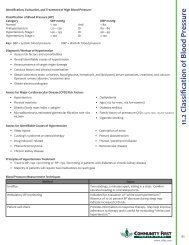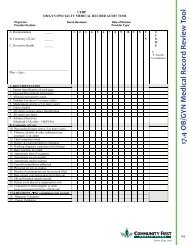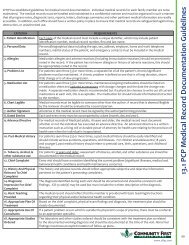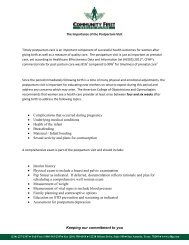Management of Common Breast Problems - Community First Health ...
Management of Common Breast Problems - Community First Health ...
Management of Common Breast Problems - Community First Health ...
Create successful ePaper yourself
Turn your PDF publications into a flip-book with our unique Google optimized e-Paper software.
<strong>Management</strong> <strong>of</strong> <strong>Common</strong> <strong>Breast</strong> <strong>Problems</strong>The evaluation <strong>of</strong> breast disease is based on risk factors and age and is determined by history, physical examination, imagingstudies, cytologic examination, and biopsy. The clinician should be able to:• Obtain a history related to breast disorders including:o Duration, onset, and cyclicity <strong>of</strong> signs and symptomso Menstrual and reproductive historyo Hormone useo Dietary habitso <strong>Breast</strong> implants• Perform a thorough physical examination <strong>of</strong> the breasts• Educate patients on technique <strong>of</strong> breast self-examination• Counsel patients on the appropriate screening and diagnostic modalities for life-threatening breast disease, such asmammography and sonography, including timing and follow-up• Diagnose and manage (consistent with training and experience) or refer for management, patients with:o A solid or cystic breast masso A mammographic abnormalityo <strong>Breast</strong> paino Physiologic and pathologic nipple dischargeo Mastitiso Fibrocystic conditions• Counsel patients on familial risk and behavioral factors related to breast diseaseTaken from the Guidelines for Women’s <strong>Health</strong> Care, Second Edition, The American College <strong>of</strong> Obstetrics and Gynecologist,s, p. 270, 2002
<strong>Management</strong> <strong>of</strong> <strong>Common</strong> <strong>Breast</strong> <strong>Problems</strong>Adapted from the Society <strong>of</strong> Surgical Oncology and the Commission on Cancer <strong>of</strong> the American College <strong>of</strong> Surgeons• Thorough communication with patients about all management options, their risks, and all test results, as well aswritten documentation <strong>of</strong> these discussions, is <strong>of</strong> the utmost importance to the provision <strong>of</strong> quality care.Palpable MassCyst• Ultrasound or cyst aspiration useful to differentiatebetween solid and cystic mass.• With aspiration, if mass does not disappear or fluid isbloody, send for cytology and refer to surgeon. Fluid canotherwise by discarded. Re-examine breast in six weeksfor recurrence. If cyst recurs refer to surgeon. Otherwise,follow routinely.Solid• Refer patient to surgeon for solid, dominant, persistentmass as biopsy is almost always indicated.• A normal mammogram does not eliminate need forfurther evaluation <strong>of</strong> a clinically suspicious mass.However, if mass is clinically benign on breast exam, andthis is confirmed by cytologic exam and mammography,patient may be followed by a surgeon every three monthsuntil biopsy or resolution <strong>of</strong> problem.• Women
















